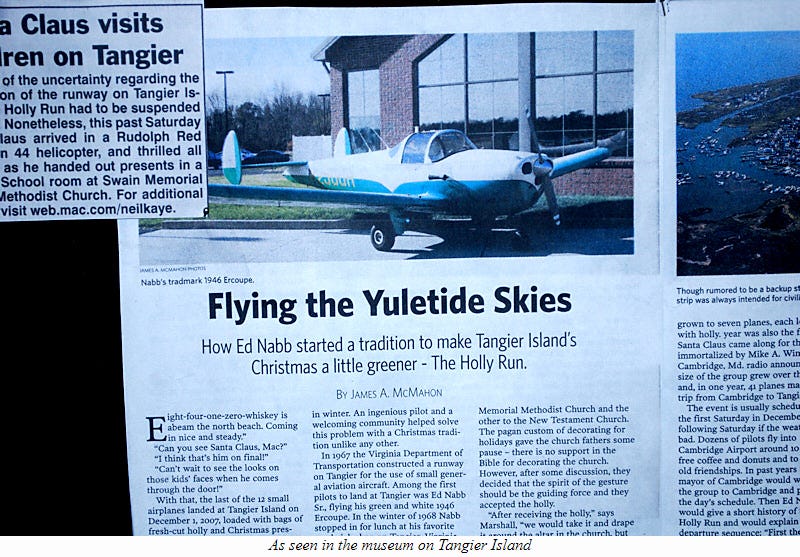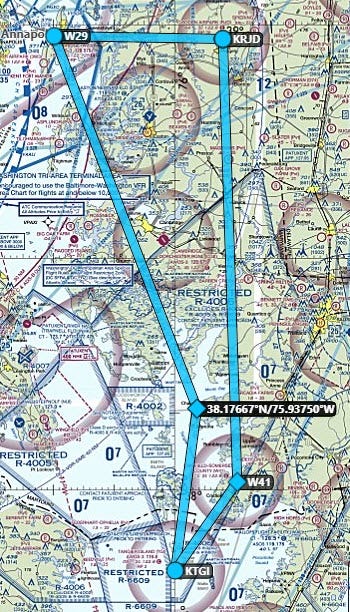The Chesapeake Bay is home to small islands that are able, barely, to sustain human habitation. There used to be more of them, but subsidence and erosion have reduced their numbers. Poplar Island used to have a town on it; now it’s a wildlife refuge kept from disappearing only by deposits of dredge spoils from the Baltimore shipping channel. Bloodworth Island hosted an oystering community until the US Navy acquired it in 1942 to use for bombing practice.
Tangier Island has been inhabited since the 1600s, and the families who live there bear the names carved on the above-water-level crypts in the side yards of many of the pier-foundation homes. Pruitt. Crockett. Parks. Eskridge. They have a distinctive accent and a unique vocabulary.
There are only two ways to get to Tangier: by water or by air. I’ve never been to Tangier by boat, but I’ve flown in at least a dozen times. The first flight I took as pilot-in-command after getting my sport pilot ticket in 2014 was to Tangier; I flew Jack, who was at that point both my particular gentleman friend and my flight instructor, for a ‘$200 crabcake’ — the pointless, makes-no-economic-sense flight that we do for the sake of demonstrating we can, and can afford to, fly planes for fun. I did my first Holly Run a few weeks later, in a rented Tecnam Eaglet. When in December 2015 I bought Miss Vivian, my 1939 Luscombe 8A, Tangier was her first cross-country flight.
(This will give you an idea of what landing at TGI is like.)
The Holly Run has been going on for more than fifty years now; the history-keepers have lost track of exactly how many, but we know it started in 1968, with a dopey little ‘46 Ercoupe and a guy named Ed Nabb.
Nabb noticed that there were no native evergreen plants on the island, and took it upon himself to organize an airlift of festive decoration. Other local pilots took up the cause and it became a yearly tradition. (And believe me — we’re always looking for an excuse to justify to our spouses/kids/parents/friends why we want to get into 85-hp deathtraps built before the Korean War and fly over nautical miles of cold water in December.)
When I first started doing Holly Runs, the focus was on the kids in the isolated, impoverished school. Sadly, since then, it’s become obvious that the real problem on the island is that there are twice as many elderly homebound shut-ins as school-age children. So we’ve transitioned from donating construction paper and glue sticks to donating easy-open cans of soup and electrolyte packets. We also gather donations (which are without fail matched by some anonymous benefactor) to buy construction supplies that are used by a team of volunteers from churches in Pennsylvania to repair roofs and floors, raise foundations, and build handicapped ramps. The battle against the subsidence and erosion is never-ending.
The day of the run the wind dictated that we land to the south. The runway at TGI is just that and nothing more: a strip of asphalt 2500 feet long and 75 feet wide. No taxiways. The parking ramp is at the north end, so if you land to the south, you have to “back taxi” the opposite direction from landing traffic until you can pull off.
This is not unusual at small uncontrolled airports; what is unusual is that 50 airplanes, with cruising speeds from 70 to 225 knots, would be landing there in a roughly 90 minute window. It requires discipline, situational awareness, clear and concise radio communication, heads on swivels, and some luck. No mishaps were had, although I did hear a few of the faster planes talking their way through go-arounds to accommodate planes still on the runway. You also have to stay out of the restricted airspace R-6609 directly to the west of the island, so the published pattern is non-standard. But everyone performed responsibly and we all got on the ground without bending metal or too much swearing.
Many of the pilots headed to the Methodist church for a simple service; Jack and I opted instead to walk the entire island before heading to Lorraine’s Restaurant for several varieties of Chesapeake blue crab.
There are actual roads, including a couple of county-maintained bridges, on Tangier, and a fair number of pickup trucks. But most of the day-to-day transportation is either by golf cart or bicycle. Jack and I walked every inch of paved road during our visit; it was less than six miles.
The inhabitants of Tangier are struggling to adapt to the 21st C. There are a number of well-maintained houses advertising their status as AirBNB properties, and dock space for pleasure boat day-trippers and tourist ferries from Crisfield and the Virginia western shore. These are meant to offset the dwindling number of working boats plied by watermen harvesting blue crab, oysters, and rockfish. At one time Tangier Island watermelons were famous throughout the Eastern seaboard and the tiny side yard gardens yielded enough produce to justify dedicated boats transporting them to Baltimore and Annapolis. That commerce is long gone and mostly forgotten.
For several months in 2002 I lived in Skagway, Alaska. Skagway is a place that most people would call remote, isolated, insular. But travelling to and from Skagway was easier, for a person without access to an airplane, than Tangier is. You could, in a vehicle with a robust suspension, drive to Whitehorse YT in a couple of hours. From there, with enough patience and prior fuel planning, you could get to Anchorage, Nome, or the lower 48. Living on an island, even an island within shouting distance of the mainland on either side of the Bay, is different. It breeds a different kind of person, and requires a different kind of sustenance if the island is to endure.







Lovely piece. Wonderful description of the island—physical and historical and cultural. I’m a Native Virginian who has been to every Virginia other than a few close to Tennessee and Kentucky. But I’ve never been to Tangier, despite a lifelong interest in the place. I have been to Smith Island, MD, just to the north. And I have been to Skagway, Alaska! Took a train ride between there and the Yukon.
Very interesting article, and quite well-written. Your observations evoke thoughts about how technology and the power of money have replaced nature as our greatest challenges as individuals.